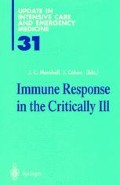Abstract
For three quarters of a century, immunologists have based their theories and experiments on the fundamental belief that the primary function of the immune system is to discriminate between self and non-self and that, if the system were perfect, it would attack everything that is non-self and be totally tolerant of anything that is self. I have abandoned this belief. Over the years too many immunological findings have accumulated that do not fit and too many questions have been raised that cannot be answered.
Access this chapter
Tax calculation will be finalised at checkout
Purchases are for personal use only
Preview
Unable to display preview. Download preview PDF.
References
Burnet FM (1959) The clonal selection theory of acquired immunity, Vanderbilt University Press, Nashville
Bretscher P, Cohn M (1970) A theory of self-nonself discrimination. Science 169:1042–1049
Lafferty KJ, Cunningham A (1975) A new analysis of allogenic interactions. Aust J Exp Biol Med Sci 53:27–42
Jenkins MK, Schwartz RH (1987) Antigen presentation by chemically modified splenocytes induces antigen-specific T cell unresponsiveness in vitro and in vivo. J Exp Med 165: 302–319
Janeway CA Jr (1989) Approaching the asymptote? Evolution and revolution in immunology. Cold Spring Harb Symp Quant Biol 54:11–13
Janeway CA Jr (1992) The immune system evolved to discriminate infectious nonself from noninfectious self. Immunol Today 13:11–16
Matzinger P (1994) Tolerance, danger, and the extended family. Annu Rev Immunol 12: 991–1045
Matzinger P, Fuchs EJ (1996) Beyond “Self” and “Non-Self”: Immunity is a conversation, not a war. J NIH Res 8:35–39
Matzinger P (1998) An innate sense of danger. Semin Immunol 10:399–415
Srivastava PK, Menoret A, Basu S, Binder RJ, McQuade KL (1998) Heat shock proteins come of age: primitive functions acquire new roles in an adaptive world. Immunity 8:657–665
Prosser CG, Eichler SJ, Farr VC, Davis SR (1992) Effect of colostrum intake on alpha-lactal-bumin concentrations in serum of calves. Res Vet Sci 53:219–222
Stelwagen K, Farr VC, McFadden HA, Prosser CG, Davis SR (1997) Time course of milk accumulation-induced opening of mammary tight junctions, and blood clearance of milk components. Am J Physiol 273: R379–R386
Duke RC, Chervanak R, Cohen JJ (1983) Endogenous endonuclease-induced DNA fragmentation: an early event in cell-mediated cytolysis. Proc Natl Acad Sci USA 80:6361–6365
Medawar PB (1954) Some immunological and endocrinological problems raised by the evolution of viviparity in vertebrates. Symp Soc Exp Biol 7:320
Bonney EA (1997) The maternal immune system’s interaction with circulating fetal cells. J Immunol 158:40–47
Fried M, Duffy PE (1996) Adherence of Plasmodium falciparum to chondroitin sulfate A in the human placenta. Science 272:1502–1504
Melguizo C, Prados J, Velez C, Aranega AE, Marchai JA, Aranega A (1997) Clinical significance of antiheart antibodies after myocardial infarction. Jpn Heart J 38:779–786
Donohoe JA, Andrus L, Bowen KM, Simeonovic C, Prowse SJ, Lafferty KJ (1983) Cultured thyroid allografts induce a state of partial tolerance in adult recipient mice. Transplantation 35:62–67
Bowen KM, Prowse SJ, Lafferty KJ (1981) The reversal of diabetes by islet transplantation: vulnerability of the established allograft. Science 213:1261–1262
Newstead CG, Johnston PA, Will EJ, Davison AM ( 1998) The case for withdrawal of cyclosporin after renal transplantation. Nephrol Dial Transplant 13:28–31
Schreiber SL, Crabtree GR (1992) The mechanism of action of cyclosporin A and FK506. Immunol Today 13:136–142
Larsen CP, Pearson TC (1997) The CD40 pathway in allograft rejection, acceptance, and tolerance. Curr Opin Immunol 9:641–647
Kirk AL, Burkly LC, Batty DS, Baumgartner RE, Berning JD, Buchanan K (1999) Treatment with humanized monoclonal antibody against CD 154 prevents acute renal allograft rejection in nonhuman primates. Nature Med 5:6686–6693
Coley WB (1898) The treatment of inoperable sarcoma with the mixed toxins of erysipelas and bacillus prodigiosus. JAMA 389–395
Boczkowski D, Nair SK, Snyder D, Gilboa E (1996) Dendritic cells pulsed with RNA are potent antigen-presenting cells in vitro and in vivo. J Exp Med 184:465–472
Dranoff G, Jaffee E, Lazenby A, et al (1993) Vaccination with irradiated tumor cells engineered to secrete murine granulocyte-macrophage colony-stimulating factor stimulates potent, specific, and long-lasting anti-tumor immunity. Proc Natl Acad Sci USA 90:3539–3543
Restifo NP (1996) The new vaccines: building viruses that elicit antitumor immunity. Curr Opin Immunol 8:658–663
Fernandez N, Duffour MT, Perricaudet M, Lotze MT, Tursz T, Zitvogel L (1998) Active specific T-cell-based immunotherapy for cancer: nucleic acids, peptides, whole native proteins, recombinant viruses, with dendritic cell adjuvants or whole tumor cell-based vaccines. Principles and future prospects. Cytokines Cell Mol Ther 4:53–65
Ertl HC, Xiang Z (1996) Novel vaccine approaches. J Immunol 156:3579–3582
Rosenberg SA, Yannelli JR, Yang JC, et al (1994) Treatment of patients with metastatic melanoma with autologous tumor-infiltrating lymphocytes and interleukin 2. J Natl Cancer Inst 86:1159–1166
Author information
Authors and Affiliations
Editor information
Editors and Affiliations
Rights and permissions
Copyright information
© 2002 Springer-Verlag Berlin Heidelberg
About this chapter
Cite this chapter
Matzinger, P. (2002). The Four Ds of the Danger Model: Distress, Damage, Destruction, and Death. In: Marshall, J.C., Cohen, J. (eds) Immune Response in the Critically Ill. Update in Intensive Care Medicine, vol 31. Springer, Berlin, Heidelberg. https://doi.org/10.1007/978-3-642-57210-4_1
Download citation
DOI: https://doi.org/10.1007/978-3-642-57210-4_1
Publisher Name: Springer, Berlin, Heidelberg
Print ISBN: 978-3-540-42589-2
Online ISBN: 978-3-642-57210-4
eBook Packages: Springer Book Archive

